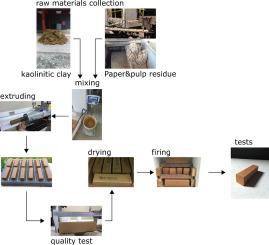当前位置:
X-MOL 学术
›
Appl. Clay. Sci.
›
论文详情
Our official English website, www.x-mol.net, welcomes your
feedback! (Note: you will need to create a separate account there.)
Assessment of mechanical, thermal, mineral and physical properties of fired clay brick made by mixing kaolinitic red clay and paper pulp residues
Applied Clay Science ( IF 5.3 ) Pub Date : 2020-11-01 , DOI: 10.1016/j.clay.2020.105847 P. Muñoz , V. Letelier , M.A. Bustamante , J. Marcos-Ortega , J.G. Sepúlveda
Applied Clay Science ( IF 5.3 ) Pub Date : 2020-11-01 , DOI: 10.1016/j.clay.2020.105847 P. Muñoz , V. Letelier , M.A. Bustamante , J. Marcos-Ortega , J.G. Sepúlveda

|
Abstract Among the largest producers of waste, the paper industry stands out due to its impact on human health and ecological balance. However, these residues may also contribute to a more environmental friendly brick industry, since the incorporation of fluxing agents may improve the firing process and the induced porosity reduces thermal conductivity of fired bricks. Therefore, this study aims to assess the feasibility of replacing clay with solid paper residue (PPR) from 2.5 to 17.5% in order to reduce resources depletion and improve brick performance. The original clay was characterized as a non-calcareous red clay with high contents of kaolinite. Several samples were made by extrusion and fired at 900 °C in accordance with industrial procedures. The addition of PPR led to increase shrinkage from 5 to 10% due to the effect of fluxing oxides which reduced pores volume and enlarged pores size. In addition, the impervious fraction was slightly reduced while the apparent porosity certainly increased (i.e. approx. 17%) due to the macroscopic pores developed by PPR combustion. This porosity produces lighter bricks (i.e. density decays from 1.76 to 1.39 g dm−3) with lower thermal conductivity (i.e. from 5.53 to 0.41 W m−1 K−1) but also reduces compressive strength (i.e. from 11 to 3 MPa) and increases water absorption (i.e. up to 24%). Nevertheless, toxicity is below the regulatory limits in all cases and fired bricks are easily adaptable to industrial procedures.
中文翻译:

用高岭土红土和纸浆残渣混合制成的烧制粘土砖的机械、热、矿物和物理性能评估
摘要 在最大的废物生产商中,造纸业因其对人类健康和生态平衡的影响而脱颖而出。然而,这些残留物也可能有助于更环保的砖工业,因为助熔剂的加入可以改善烧制过程,而诱发的孔隙率会降低烧制砖的热导率。因此,本研究旨在评估用 2.5% 至 17.5% 的固体纸渣 (PPR) 代替粘土的可行性,以减少资源消耗并提高砖的性能。原始粘土的特征是高岭石含量高的非钙质红粘土。根据工业程序,通过挤压制成几个样品并在 900 °C 下烧制。由于助熔氧化物的影响,PPR 的加入导致收缩率从 5% 增加到 10%,这会减少孔体积和扩大孔尺寸。此外,由于 PPR 燃烧产生的宏观孔隙,不透水部分略有减少,而表观孔隙率肯定增加(即约 17%)。这种孔隙率会产生较轻的砖(即密度从 1.76 克 dm-3 衰减到 1.39 g dm-3),导热系数较低(即从 5.53 到 0.41 W m-1 K-1),但也会降低抗压强度(即从 11 到 3 MPa)和增加吸水率(即高达 24%)。然而,在所有情况下,毒性都低于监管限制,并且烧制砖很容易适应工业程序。由于 PPR 燃烧产生的宏观孔隙,不透水部分略有减少,而表观孔隙率肯定增加(即约 17%)。这种孔隙率会产生较轻的砖(即密度从 1.76 克 dm-3 衰减到 1.39 g dm-3),导热系数较低(即从 5.53 到 0.41 W m-1 K-1),但也会降低抗压强度(即从 11 到 3 MPa)和增加吸水率(即高达 24%)。然而,在所有情况下,毒性都低于监管限制,并且烧制砖很容易适应工业程序。由于 PPR 燃烧产生的宏观孔隙,不透水部分略有减少,而表观孔隙率肯定增加(即约 17%)。这种孔隙率会产生较轻的砖(即密度从 1.76 克 dm-3 衰减到 1.39 g dm-3),导热系数较低(即从 5.53 到 0.41 W m-1 K-1),但也会降低抗压强度(即从 11 到 3 MPa)和增加吸水率(即高达 24%)。然而,在所有情况下,毒性都低于监管限制,并且烧制砖很容易适应工业程序。从 11 到 3 MPa)并增加吸水率(即高达 24%)。然而,在所有情况下,毒性都低于监管限制,并且烧制砖很容易适应工业程序。从 11 到 3 MPa)并增加吸水率(即高达 24%)。然而,在所有情况下,毒性都低于监管限制,并且烧制砖很容易适应工业程序。
更新日期:2020-11-01
中文翻译:

用高岭土红土和纸浆残渣混合制成的烧制粘土砖的机械、热、矿物和物理性能评估
摘要 在最大的废物生产商中,造纸业因其对人类健康和生态平衡的影响而脱颖而出。然而,这些残留物也可能有助于更环保的砖工业,因为助熔剂的加入可以改善烧制过程,而诱发的孔隙率会降低烧制砖的热导率。因此,本研究旨在评估用 2.5% 至 17.5% 的固体纸渣 (PPR) 代替粘土的可行性,以减少资源消耗并提高砖的性能。原始粘土的特征是高岭石含量高的非钙质红粘土。根据工业程序,通过挤压制成几个样品并在 900 °C 下烧制。由于助熔氧化物的影响,PPR 的加入导致收缩率从 5% 增加到 10%,这会减少孔体积和扩大孔尺寸。此外,由于 PPR 燃烧产生的宏观孔隙,不透水部分略有减少,而表观孔隙率肯定增加(即约 17%)。这种孔隙率会产生较轻的砖(即密度从 1.76 克 dm-3 衰减到 1.39 g dm-3),导热系数较低(即从 5.53 到 0.41 W m-1 K-1),但也会降低抗压强度(即从 11 到 3 MPa)和增加吸水率(即高达 24%)。然而,在所有情况下,毒性都低于监管限制,并且烧制砖很容易适应工业程序。由于 PPR 燃烧产生的宏观孔隙,不透水部分略有减少,而表观孔隙率肯定增加(即约 17%)。这种孔隙率会产生较轻的砖(即密度从 1.76 克 dm-3 衰减到 1.39 g dm-3),导热系数较低(即从 5.53 到 0.41 W m-1 K-1),但也会降低抗压强度(即从 11 到 3 MPa)和增加吸水率(即高达 24%)。然而,在所有情况下,毒性都低于监管限制,并且烧制砖很容易适应工业程序。由于 PPR 燃烧产生的宏观孔隙,不透水部分略有减少,而表观孔隙率肯定增加(即约 17%)。这种孔隙率会产生较轻的砖(即密度从 1.76 克 dm-3 衰减到 1.39 g dm-3),导热系数较低(即从 5.53 到 0.41 W m-1 K-1),但也会降低抗压强度(即从 11 到 3 MPa)和增加吸水率(即高达 24%)。然而,在所有情况下,毒性都低于监管限制,并且烧制砖很容易适应工业程序。从 11 到 3 MPa)并增加吸水率(即高达 24%)。然而,在所有情况下,毒性都低于监管限制,并且烧制砖很容易适应工业程序。从 11 到 3 MPa)并增加吸水率(即高达 24%)。然而,在所有情况下,毒性都低于监管限制,并且烧制砖很容易适应工业程序。











































 京公网安备 11010802027423号
京公网安备 11010802027423号